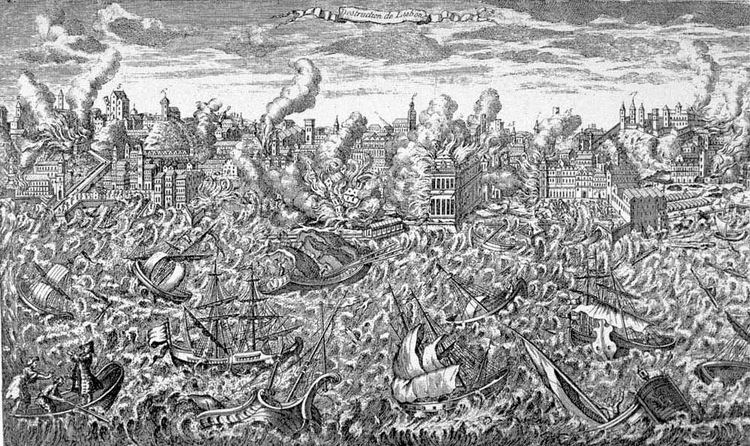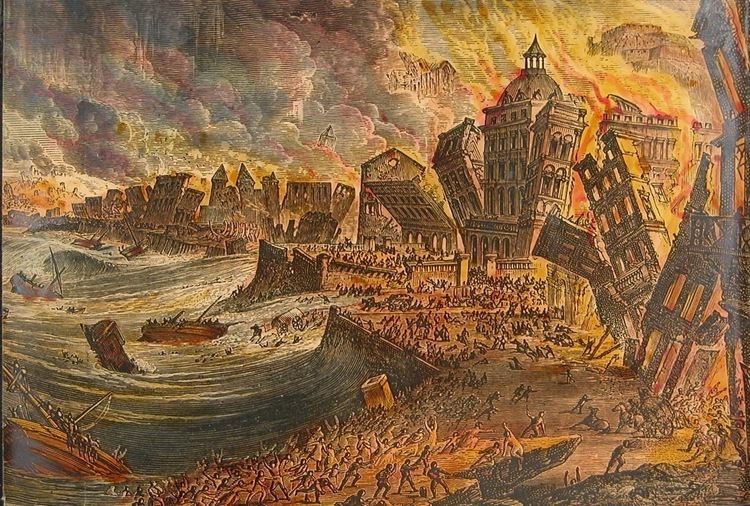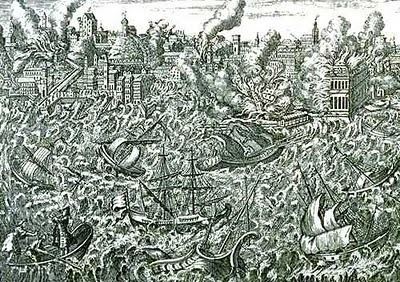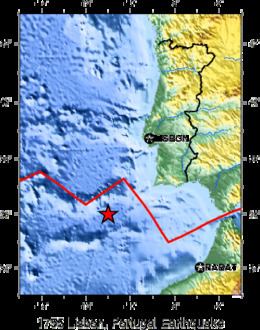Magnitude 8.5–9.0 Mw (est.) Casualties 10,000–100,000 deaths | Max. intensity XI (Extreme) Date 1 November 1755 | |
 | ||
Areas affected Kingdom of Portugal, Kingdom of Spain, Kingdom of Morocco. The tsunami affected Southern Great Britain and Ireland Similar 2004 Indian Ocean ea, 1960 Valdivia earthquake, 1906 San Francisco earthquake, 1969 Portugal earthquake, 1908 Messina earthquake | ||
1755 lisbon earthquake
The 1755 Lisbon earthquake, also known as the Great Lisbon earthquake, occurred in the Kingdom of Portugal on Saturday, 1 November, the holy day of All Saints' Day, at around 09:40 local time. In combination with subsequent fires and a tsunami, the earthquake almost totally destroyed Lisbon and adjoining areas. Seismologists today estimate the Lisbon earthquake had a magnitude in the range 8.5–9.0 on the moment magnitude scale, with its epicentre in the Atlantic Ocean about 200 km (120 mi) west-southwest of Cape St. Vincent. Estimates place the death toll in Lisbon alone between 10,000 and 100,000 people, making it one of the deadliest earthquakes in history.
Contents
- 1755 lisbon earthquake
- Panel on the 1755 lisbon earthquake part 1
- Earthquake and tsunami
- Casualties and damage
- Relief and reconstruction efforts
- Effect on society economy and philosophy
- Economy
- Philosophy
- Politics
- Development of seismology
- References

The earthquake accentuated political tensions in the Kingdom of Portugal and profoundly disrupted the country's colonial ambitions. The event was widely discussed and dwelt upon by European Enlightenment philosophers, and inspired major developments in theodicy. As the first earthquake studied scientifically for its effects over a large area, it led to the birth of modern seismology and earthquake engineering.

Panel on the 1755 lisbon earthquake part 1
Earthquake and tsunami

In 1755, the earthquake struck on the morning of 1 November, the holy day of All Saints' Day. Contemporary reports state that the earthquake lasted between three and a half and six minutes, causing fissures 5 metres (16 feet) wide to open in the city centre. Survivors rushed to the open space of the docks for safety and watched as the water receded, revealing a sea floor littered with lost cargo and shipwrecks. Approximately 40 minutes after the earthquake, a tsunami engulfed the harbour and downtown area, rushing up the Tagus river, "so fast that several people riding on horseback ... were forced to gallop as fast as possible to the upper grounds for fear of being carried away." It was followed by two more waves. In the areas unaffected by the tsunami, fire quickly broke out, and flames raged for five days.

Lisbon was not the only Portuguese city affected by the catastrophe. Throughout the south of the country, in particular the Algarve, destruction was rampant. The tsunami destroyed some coastal fortresses in the Algarve and, in the lower levels, it razed several houses. Almost all the coastal towns and villages of the Algarve were heavily damaged, except Faro, which was protected by the sandy banks of Ria Formosa. In Lagos, the waves reached the top of the city walls. Other towns of different Portuguese regions, such as Peniche, Cascais, and even Covilhã, which is located near the Serra da Estrela mountain range in central inland Portugal, were affected. The shock waves of the earthquake destroyed part of Covilhã's castle walls and its large towers. On the island of Madeira, Funchal and many smaller settlements suffered significant damage. Almost all of the ports in the Azores archipelago suffered most of their destruction from the tsunami, with the sea penetrating about 150 m inland.

Shocks from the earthquake were felt throughout Europe as far as Finland and North Africa, and according to some sources even in Greenland, and the Caribbean. Tsunamis as tall as 20 metres (66 ft) swept the coast of North Africa, and struck Martinique and Barbados across the Atlantic. A three-metre (ten-foot) tsunami hit Cornwall on the southern English coast. Galway, on the west coast of Ireland, was also hit, resulting in partial destruction of the "Spanish Arch" section of the city wall. At Kinsale, several vessels were whirled round in the harbor, and water poured into the marketplace.

In 2015, it was revealed that the tsunami waves may have reached the coast of Brazil, then a colony of Portugal. Such a hypothesis was raised by reviewing letters sent by Brazilian authorities at the time of the earthquake. These letters describe damage and destruction caused by gigantic waves.
Although seismologists and geologists have always agreed that the epicentre was in the Atlantic to the West of the Iberian Peninsula, its exact location has been a subject of considerable debate. Early hypotheses had proposed the Gorringe Ridge until simulations showed that a source closer to the shore of Portugal was required to comply with the observed effects of the tsunami. A seismic reflection survey of the ocean floor along the Azores–Gibraltar Transform Fault has revealed a 50 km-long thrust structure southwest of Cape St. Vincent, with a dip-slip throw of more than 1 km. This structure may have created the primary tectonic event.
Casualties and damage
Economic historian Álvaro Pereira estimated that of Lisbon's population of approximately 200,000 people, some 30,000–40,000 were killed; another 10,000 may have lost their lives in Morocco. However, a 2009 study of contemporary reports relating to the 1 November event found them vague and difficult to separate from reports of another local series of earthquakes on 18–19 November. Pereira estimated the total death toll in Portugal, Spain and Morocco from the earthquake and the resulting fires and tsunami at 40,000 to 50,000 people.
Eighty-five percent of Lisbon's buildings were destroyed, including famous palaces and libraries, as well as most examples of Portugal's distinctive 16th-century Manueline architecture. Several buildings that had suffered little earthquake damage were destroyed by the subsequent fire. The new Lisbon opera house (the "Ópera do Tejo"), opened just six months before, burned to the ground. The Royal Ribeira Palace, which stood just beside the Tagus river in the modern square of Terreiro do Paço, was destroyed by the earthquake and tsunami. Inside, the 70,000-volume royal library as well as hundreds of works of art, including paintings by Titian, Rubens, and Correggio, were lost. The royal archives disappeared together with detailed historical records of explorations by Vasco da Gama and other early navigators. The palace of Henrique de Meneses, 3rd Marquis of Louriçal, which housed an invaluable library of 18,000 books, was also destroyed. The earthquake damaged several major churches in Lisbon, namely the Lisbon Cathedral, the Basilicas of São Paulo, Santa Catarina, São Vicente de Fora, and the Misericórdia Church. The Royal Hospital of All Saints (the largest public hospital at the time) in the Rossio square was consumed by fire and hundreds of patients burned to death. The tomb of national hero Nuno Álvares Pereira was also lost. Visitors to Lisbon may still walk the ruins of the Carmo Convent, which were preserved to remind Lisboners of the destruction.
Relief and reconstruction efforts
The royal family escaped unharmed from the catastrophe: King Joseph I of Portugal and the court had left the city, after attending mass at sunrise, fulfilling the wish of one of the king's daughters to spend the holiday away from Lisbon. After the catastrophe, Joseph I developed a fear of living within walls, and the court was accommodated in a huge complex of tents and pavilions in the hills of Ajuda, then on the outskirts of Lisbon. The king's claustrophobia never waned, and it was only after Joseph's death that his daughter Maria I of Portugal began building the royal Ajuda Palace, which still stands on the site of the old tented camp. Like the king, the prime minister Sebastião de Melo (the Marquis of Pombal) survived the earthquake. When asked what was to be done, Pombal reportedly replied "Bury the dead and heal the living", and set about organizing relief and rehabilitation efforts. Firefighters were sent to extinguish the raging flames, and teams of workers and ordinary citizens were ordered to remove the thousands of corpses before disease could spread. Contrary to custom and against the wishes of the Church, many corpses were loaded onto barges and buried at sea beyond the mouth of the Tagus. To prevent disorder in the ruined city, the Portuguese Army was deployed and gallows were constructed at high points around the city to deter looters; more than thirty people were publicly executed. The army prevented many able-bodied citizens from fleeing, pressing them into relief and reconstruction work.
The king and the prime minister immediately launched efforts to rebuild the city. On 4 December 1755, little more than a month after the earthquake, Manuel da Maia, chief engineer to the realm, presented his plans for the re-building of Lisbon. Maia presented four options from abandoning Lisbon to building a completely new city. The first plan was to rebuild the old city using re-cycled materials; this was the cheapest option. The second and third plans proposed widening certain streets. The fourth option boldly proposed razing the entire Baixa quarter and "laying out new streets without restraint". This last option was chosen by the king and his minister.
In less than a year, the city was cleared of debris. Keen to have a new and perfectly ordered city, the king commissioned the construction of big squares, rectilinear, large avenues and widened streets – the new mottos of Lisbon.
The Pombaline buildings are among the earliest seismically protected constructions in Europe. Small wooden models were built for testing, and earthquakes were simulated by marching troops around them. Lisbon's "new" Lower Town, known today as the Pombaline Lower Town (Baixa Pombalina), is one of the city's famed attractions. Sections of other Portuguese cities, such as the Vila Real de Santo António in Algarve, were also rebuilt along Pombaline principles.
The Casa Pia, a Portuguese institution founded by Maria I (known as A Pia, "Maria the Pious"), and organized by Police Intendant Pina Manique in 1780, was founded following the social disarray of the 1755 Lisbon earthquake.
Effect on society, economy and philosophy
The earthquake had wide-ranging effects on the lives of the populace and intelligentsia. The earthquake had struck on an important religious holiday and had destroyed almost every important church in the city, causing anxiety and confusion amongst the citizens of a staunch and devout Roman Catholic country. Theologians and philosophers focused and speculated on the religious cause and message, seeing the earthquake as a manifestation of divine judgment.
Economy
A 2009 study estimated that the earthquake cost between 32 and 48 percent of Portugal's GDP. Also, "in spite of strict controls, prices and wages remained volatile in the years after the tragedy. The recovery from the earthquake also led to a rise in the wage premium of construction workers. More significantly, the earthquake became an opportunity to reform the economy and to reduce the economic semi-dependency vis-à-vis Britain."
Philosophy
The earthquake and its fallout strongly influenced the intelligentsia of the European Age of Enlightenment. The noted writer-philosopher Voltaire used the earthquake in Candide and in his Poème sur le désastre de Lisbonne ("Poem on the Lisbon disaster"). Voltaire's Candide attacks the notion that all is for the best in this, "the best of all possible worlds", a world closely supervised by a benevolent deity. The Lisbon disaster provided a counterexample. As Theodor Adorno wrote, "[t]he earthquake of Lisbon sufficed to cure Voltaire of the theodicy of Leibniz" (Negative Dialectics 361). In the later twentieth century, following Adorno, the 1755 earthquake has sometimes been compared to the Holocaust as a catastrophe that transformed European culture and philosophy. Jean-Jacques Rousseau was also influenced by the devastation following the earthquake, whose severity he believed was due to too many people living within the close quarters of the city. Rousseau used the earthquake as an argument against cities as part of his desire for a more naturalistic way of life.
Immanuel Kant published three separate texts on the Lisbon earthquake. As a younger man, fascinated with the earthquake, he collected all the information available to him in news pamphlets, and used it to formulate a theory of the causes of earthquakes. Kant's theory, which involved the shifting of huge subterranean caverns filled with hot gases, was (though ultimately shown to be incorrect) one of the first systematic modern attempts to explain earthquakes by positing natural, rather than supernatural, causes. According to Walter Benjamin, Kant's slim early book on the earthquake "probably represents the beginnings of scientific geography in Germany. And certainly the beginnings of seismology."
Werner Hamacher has claimed that the earthquake's consequences extended into the vocabulary of philosophy, making the common metaphor of firm "grounding" for philosophers' arguments shaky and uncertain: "Under the impression exerted by the Lisbon earthquake, which touched the European mind in one [of] its more sensitive epochs, the metaphor of ground and tremor completely lost their apparent innocence; they were no longer merely figures of speech" (263). Hamacher claims that the foundational certainty of Descartes' philosophy began to shake following the Lisbon earthquake.
Politics
The earthquake had a major impact on Portuguese politics. The prime minister was the favorite of the king, but the aristocracy despised him as an upstart son of a country squire (although Prime Minister Sebastião de Melo is known today as Marquis of Pombal, the title was only granted in 1770, fifteen years after the earthquake). The prime minister in turn disliked the old nobles, whom he considered corrupt and incapable of practical action. Before 1 November 1755 there was a constant struggle for power and royal favor, but the competent response of the Marquis of Pombal effectively severed the power of the old aristocratic factions. However, silent opposition and resentment of King Joseph I began to rise, which would culminate with the attempted assassination of the king, and the subsequent elimination of the powerful Duke of Aveiro and the Távora family.
Development of seismology
The prime minister's response was not limited to the practicalities of reconstruction. He ordered a query sent to all parishes of the country regarding the earthquake and its effects. Questions included:
The answers to these and other questions are still archived in the Torre do Tombo, the national historical archive. Studying and cross-referencing the priests' accounts, modern scientists were able to reconstruct the event from a scientific perspective. Without the questionnaire designed by the Marquis of Pombal, this would have been impossible. Because the marquis was the first to attempt an objective scientific description of the broad causes and consequences of an earthquake, he is regarded as a forerunner of modern seismological scientists.
The geological causes of this earthquake and the seismic activity in the region continue to be discussed and debated by contemporary scientists.
